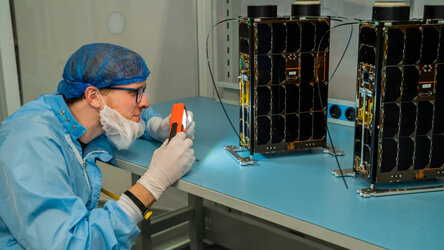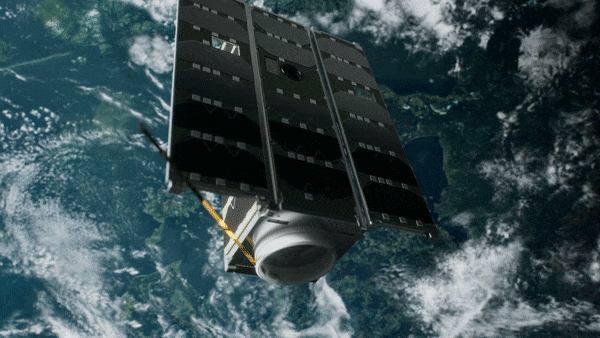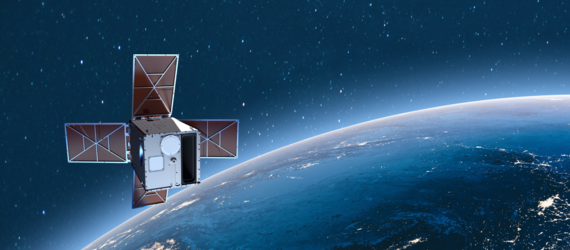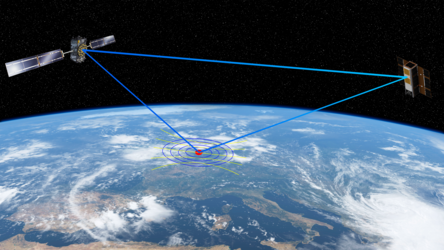Vega’s ESTCube-2 tether to the future
Estonia’s next satellite will fly aboard Europe’s Vega VV23 launcher later this week. While largely designed and built by undergraduate students, the shoebox-sized ESTCube-2 has ambitious goals in mind, including surveys of Estonian vegetation and the first successful in-orbit demonstration of ‘plasma brake’ technology. Deployment of a charged microtether will slow the CubeSat’s orbit, proving the prospect of helping to keep space clear of dangerous debris in the future.

If successful, ESTCube-2’s plasma braking would mark the first use of electric sail, or E-sail, technology, devised by Pekka Janhunen of the Finnish Meterological Institute (FMI) as a propellant-free means of exploring the Solar System. Beyond Earth’s magnetic field, electrostatic charging of satellite tethers would cause them to repel protons of the solar wind, lending them momentum in the process.
Closer to Earth, the magnetosphere repels the solar wind. Instead an e-sail can perform the opposite function: the charged tether would repel the nearly stationary plasma making up our planet’s ionosphere – an electrically active outer layer of our atmosphere – and cause drag as a result, leading it to slow down and its orbit to decay accordingly.

Hair-thick tether technology
Plasma brakes therefore offer a low-cost, low-mass method of quickly removing satellites from orbit after their mission ends, marketed commercially through Finland’s Aurora Propulsion Technologies.
ESTCube-2’s plasma brake e-sail is a 50-m long interweaved aluminium tether line made up of wires each just 50 micrometres (0.05 mm) in thickness – around the diameter of the average human hair.

Pekka Janhunen explains: “Historically, tethers have been prone to snap in space due to micrometeorites or other hazards, so ESTCube-2’s net-like microtether design brings added redundancy with two parallel and two zig-zagging bonded wires.”
Student-built satellite
ESTCube-2 has been developed and built by a team from Tartu Observatory of the University of Tartu and student organisation Tudengisatelliit.
The miniature mission also carries student-built microcameras to survey Estonian vegetation, based on a design originally developed for ESA’s European Student Earth Orbiter mission.
Their results will be compared to the full-size Copernicus Sentinel-2 mission, as well as a materials payload investigating the corrosive effects of ‘atomic oxygen’ found at the top of the atmosphere, plus a software defined radio for amateur radio tests.

A 3-unit ‘CubeSat’ – a low-cost satellite built up from standardised 10 cm boxes – ESTCube-2 is due to fly on Vega’s Small Spacecraft Mission Service, a rideshare service for small satellites. It secured its place through the European Commission’s In-Orbit Demonstration/In-Orbit Validation programme.
Early in-orbit testing for novel technologies
Managed on behalf of the Commission by ESA’s Small Satellite Platform Unit, this programme allows the early orbital testing of new technologies to make Europe’s space sector more competitive.

“As a volunteer student project, this IOD/IOV programme is ideal,” explains ESTCube-2 project manager Hans Teras. “It fits nicely with our timeline, including the testing we needed to be sure of our performance. Well over 600 university students across all study levels have played some role in making ESTCube-2 happen, but the mission as a whole is very ambitious, pushing the boundaries of what students can do.”
ESTCube-2 will fly a decade after its predecessor, ESTCube-1, which launched on a Vega in 2013. It too carried an E-sail payload from FMI, but a motor problem meant it failed to deploy.
ESTCube-2 is equipped with a stronger, more robust deploying motor that has undergone extensive mechanical testing.

“The ESTCube-2 team has invested eight years of development work in order to have another chance of testing the revolutionary E-sail propulsion concept in orbit”, explains the University of Tartu associated professor Andris Slavinskis who led the transition from ESTCube-1 to ESTCube-2.
Kristo Allaje, Principal Systems Engineer of ESTCube-2, adds: “Last time we could encourage students to join us by the challenge of being the first Estonian satellite. This time we have to motivate them in another way, by asking them to enable excellent science.”
Around a year into the mission ESTCube-2 will be spun up using its reaction wheels. The ensuing centrifugal force should help serve to deploy the E-sail in a sufficiently taut fashion.

If successful, the E-sail is expected to lower the orbit of ESTCube-2 much more rapidly than normal.
Follow-up mission ESTCube-LuNa is being designed to test an E-sail beyond Earth orbit, to prove its usefulness as a method of deep space propulsion.
ESA has recently studied E-sail technology as an economical means of prospecting asteroids.

Earth monitoring and space effects study
ESTCube-2 pair of student-made microcameras designed have been optimised for the ‘Normalised Difference Vegetation’ index to reveal plant health. The camera pair will be tilted as needed to observe Estonian territory as often as possible, offering more frequent revisits than other Earth observation missions.
Tartu University spin-off company Captain Corrosion is supporting a experiment mounted on ESTCube-2’s hull. A set of 16 different materials will be evaluated for their resistance to ‘atomic oxygen’ – a variety of oxygen normally encountered only in low orbits, known to eat away at satellite surfaces.
ESTCube-2’s software defined radio will also be busy, including transmitting 8-second video clips prerecorded by Estonian citizens, connecting to Estonian schools along its swath and performing ranging experiments with amateur radio enthusiasts.
Vega flight VV23 is due for lift-off this week from Europe’s Spaceport in French Guiana. Along with its main satellite payloads it carries multiple CubeSats including ESA’s PRETTY mission investigating reflected satnav for environmental monitoring, the Proba-V Companion CubeSat testing the performance of a previously flown spectral imager aboard a CubeSat and other IOD/IOV CubeSats.















 Germany
Germany
 Austria
Austria
 Belgium
Belgium
 Denmark
Denmark
 Spain
Spain
 Estonia
Estonia
 Finland
Finland
 France
France
 Greece
Greece
 Hungary
Hungary
 Ireland
Ireland
 Italy
Italy
 Luxembourg
Luxembourg
 Norway
Norway
 The Netherlands
The Netherlands
 Poland
Poland
 Portugal
Portugal
 Czechia
Czechia
 Romania
Romania
 United Kingdom
United Kingdom
 Slovenia
Slovenia
 Sweden
Sweden
 Switzerland
Switzerland
































